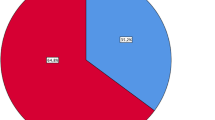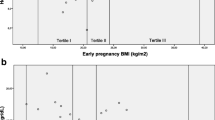Abstract
Objectives
To identify maternal and perinatal risk factors associated with childhood anaemia.
Methods
A retrospective cohort study was conducted in three remote Katherine East Aboriginal communities in Northern Territory, Australia. Children born 2004–2014 in Community A and 2010–2014 in Community B and C, and their respective mothers were recruited into the study. Maternal and child data were linked to provide a longitudinal view of each child for the first 1000 days from conception to 2-years of age. Descriptive analyses were used to calculate mean maternal age, and proportions were used to describe other antenatal and perinatal characteristics of the mother/child dyads. The main outcome was the prevalence of maternal anaemia in pregnancy and risk factors associated with childhood anaemia at age 6 months.
Results
Prevalence of maternal anaemia in pregnancy was higher in the third trimester (62%) compared to the first (46%) and second trimesters (48%). There was a strong positive linear association (R2 = 0.46, p < 0.001) between maternal haemoglobin (Hb) in third trimester pregnancy and child Hb at age 6 months. Maternal anaemia in pregnancy (OR 4.42 95% CI 2.08–9.36) and low birth weight (LBW, OR 2.62, 95% CI 1.21–5.70) were associated with an increased risk of childhood anaemia at 6 months of age.
Conclusions for Practice
This is the first study to identify the association of maternal anaemia with childhood anaemia in the Australian Aboriginal population. A review of current policies and practices for anaemia screening, prevention and treatment during pregnancy and early childhood would be beneficial to both mother and child. Our findings indicate that administering prophylactic iron supplementation only to children who are born LBW or premature would be of greater benefit if expanded to include children born to anaemic mothers.

Similar content being viewed by others
References
Aquino, D., Leonard, D., Hadgraft, N., & Marley, J. V. (2018). High prevalence of early onset anaemia amongst Aboriginal and Torres Strait Islander infants in remote northern Australia. Australian Journal of Rural Health,26(4), 245–250. https://doi.org/10.1111/ajr.12403.
Bar-Zeev, S., Barclay, L., Kruske, S., & Kildea, S. (2014). Factors affecting the quality of antenatal care provided to remote dwelling Aboriginal women in northern Australia. Midwifery,30(3), 289–296. https://doi.org/10.1016/j.midw.2013.04.009.
Brimblecombe, J., Ferguson, M., Liberato, S., & O’Dea, K. (2013). Characteristics of the community-level diet of aboriginal people in remote northern Australia. Medical Journal of Australia,198, 380–384.
Central Australian Remote Practitioners Association. (2014). CARPA Standard Treatment Manual (6th ed.). Alice Springs: Centre for Remote Health.
Central Australian Rural Practitioners Association (Ed.). (2003). CARPA standard treatment manual, 4th edition.
Central Australian Rural Practitioners Association Editorial Committee (Ed.) (2009). CARPA Standard Treatment Manual: A clinic manual for primary health care practitioners in remote and rural communities in Central and Northern Australia (5th ed.). Central Australian Rural Practitioners Association.
Churchill, D., Nair, M., Stanworth, S. J., & Knight, M. (2019). The change in haemoglobin concentration between the first and third trimesters of pregnancy: A population study. BMC Pregnancy and Childbirth,19(1), 359. https://doi.org/10.1186/s12884-019-2495-0.
Colomer, J., Colomer, C., Gutierrez, D., Jubert, A., Nolasco, A., Donat, J., et al. (1990). Anaemia during pregnancy as a risk factor for infant iron deficiency: Report from the Valencia Infant Anaemia Cohort (VIAC) study. Paediatric and Perinatal Epidemiology,4(2), 196–204. https://doi.org/10.1111/j.1365-3016.1990.tb00638.x.
Congress Alukura and Nganampa Health Council Inc. (Ed.). (2008). Minymaku Kutju Tjukurpa Women’s Business Manual (4th ed.). Richmond: Graphic Print Group.
Currie, B. J., & Brewster, D. R. (2001). Childhood infections in the tropical north of Australia. Journal of Paediatrics and Child Health, 37(4), 326–330. https://ezproxy.cdu.edu.au/login?url=https://search.ebscohost.com/login.aspx?direct=true&AuthType=ip,url,cookie,uid&db=mnh&AN=11532049&site=ehost-live.
de Pee, S., Bloem, M. W., Sari, M., Kiess, L., Yip, R., & Kosen, S. (2002). The high prevalence of low hemoglobin concentration among Indonesian infants aged 3–5 months is related to maternal anemia. The Journal of Nutrition, 132(8), 2215–2221. https://jn.nutrition.org/content/132/8/2215.abstract.
Hall, J., Case, A., & O’Neil, L. (2015). Mothers and Babies 2013. https://digitallibrary.health.nt.gov.au/prodjspui/bitstream/10137/640/1/Mother%20and%20Babies%202013.pdf.
Hamilton, D. F., Ghert, M., & Simpson, A. H. R. W. (2015). Interpreting regression models in clinical outcome studies. Bone and Joint Research,4(9), 152–153. https://doi.org/10.1302/2046-3758.49.2000571.
Hiscock, R., Kumar, D., & Simmons, S. W. (2015). Systematic review and meta-analysis of method comparison studies of Masimo pulse co-oximeters (Radical-7 or Pronto-7) and HemoCue(R) absorption spectrometers (B-Hemoglobin or 201+) with laboratory haemoglobin estimation. Anaesthesia and Intensive Care,43(3), 341–350. https://doi.org/10.1177/0310057x1504300310.
Kassebaum, N. J. (2016). The global burden of anemia. Hematology/Oncology Clinics of North America,30(2), 247–308. https://doi.org/10.1016/j.hoc.2015.11.002.
Khambalia, A. Z., Aimone, A. M., & Zlotkin, S. H. (2011). Burden of anemia among indigenous populations. Nutrition Reviews, 69(12), 693–719.
Kilbride, J., Baker, T. G., Parapia, L. A., Khoury, S. A., Shuqaidef, S. W., & Jerwood, D. (1999). Anaemia during pregnancy as a risk factor for iron-deficiency anaemia in infancy: A case–control study in Jordan. International Journal of Epidemiology,28(3), 461–468.
Malenica, M., Prnjavorac, B., Bego, T., Dujic, T., Semiz, S., Skrbo, S., et al. (2017). Effect of cigarette smoking on haematological parameters in healthy population. Medical Archives,71(2), 132–136. https://doi.org/10.5455/medarh.2017.71.132-136.
Manuals, R. P. H. C. (2014a). Minymaku Kutju Tjukurpa Women's Business Manual, 5th edition.
Manuals, R. P. H. C. (2014b). Reference Book for the Remote Primary Health Care Manuals.
Meinzen-Derr, J. K., Guerrero, M. L., Altaye, M., Ortega-Gallegos, H., Ruiz-Palacios, G. M., & Morrow, A. L. (2006). Risk of infant anemia is associated with exclusive breast-feeding and maternal anemia in a Mexican cohort. Journal of Nutrition,136(2), 452–458.
Nair, K. M., Fernandez-Rao, S., Nagalla, B., Kankipati, R. V., Punjal, R., Augustine, L. F., et al. (2016). Characterisation of anaemia and associated factors among infants and pre-schoolers from rural India. Public Health Nutrition,19(5), 861–871. https://doi.org/10.1017/s1368980015002050.
Northern Territory Government Department of Health. (2015). Healthy Under 5 Kids Program, Growth and Nutrition Report, NT Annual Report 2015. Retrieved from Darwin.
Rabindrakumar, M. S. K., Pujitha Wickramasinghe, V., Gooneratne, L., Arambepola, C., Senanayake, H., & Thoradeniya, T. (2018). The role of haematological indices in predicting early iron deficiency among pregnant women in an urban area of Sri Lanka. BMC Hematology,18(1), 37. https://doi.org/10.1186/s12878-018-0131-2.
Remote Primary Health Care Manuals. (2017a). CARPA Standard Treatment Manual (7th edition). https://docs.remotephcmanuals.com.au/review/g/manuals2017-manuals/d/20318.html?page=1.
Remote Primary Health Care Manuals. (2017b). Minymaku Kutju Tjukurpa Women’s Business Manual. https://docs.remotephcmanuals.com.au/review/g/manuals2017-manuals/d/20272.html?page=2.
Rumbold, A. R., Bailie, R. S., Si, D., Dowden, M. C., Kennedy, C. M., Cox, R. J., et al. (2011). Delivery of maternal health care in Indigenous primary care services: Baseline data for an ongoing quality improvement initiative. BMC Pregnancy and Childbirth,11, 16. https://doi.org/10.1186/1471-2393-11-16.
Sunrise Health Service Aboriginal Corporation. (2019). Community profiles. https://www.sunrise.org.au/community-profiles.
World Health Organization. (2016). WHO recommendations on antenatal care for a positive pregnancy experience. Luxembourg: WHO. https://apps.who.int/iris/bitstream/handle/10665/250796/9789241549912-eng.pdf;jsessionid=F9D12F692AE2D4336CA09636523D3E07?sequence=1.
Author information
Authors and Affiliations
Corresponding author
Additional information
Publisher's Note
Springer Nature remains neutral with regard to jurisdictional claims in published maps and institutional affiliations.
Electronic supplementary material
Below is the link to the electronic supplementary material.
Rights and permissions
About this article
Cite this article
Hansen, M., Singh, G., Barzi, F. et al. Maternal Anaemia in Pregnancy: A Significantly Greater Risk Factor for Anaemia in Australian Aboriginal Children than Low Birth Weight or Prematurity. Matern Child Health J 24, 979–985 (2020). https://doi.org/10.1007/s10995-020-02913-7
Published:
Issue Date:
DOI: https://doi.org/10.1007/s10995-020-02913-7




